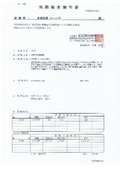チタン光触媒材料『チタニスター(R)』※酸化分解能力と親水能力
光触媒能力の実証試験を実施!酸化分解能力、超親水能力についてご紹介
一般に光触媒は有機物質や有害物質を酸化分解して無害化する、酸化分解能力。 励起状態になった光触媒表面で起こる、親水能力があるといわれています。 これらの光触媒能力の実証試験を行いました。 ・酸化分解能力 100mm角に裁断した純チタン金属の基材種である不織布状の純チタンに ガスタイプのチタニスター処理を施し、およそ250ppmアセトアルデヒドガスと 共にテドラーバックに封入し吸着平衡に達した後、上部から1mW/cm2の BLBランプを照射し、一定時間ごとにアセトアルデヒドガス濃度と 反応生成物質の二酸化炭素濃度を測定しました。 チタニスターによってアセトアルデヒドガス濃度が減少するとともに 反応生成物質の二酸化炭素濃度が増加し、最終的には約230ppm アセトアルデヒドガスがほぼ分解されるとともにアセトアルデヒドガス 濃度の2倍量の反応複製性物質が生成されていることがわかりました。 ※詳しくはPDF資料をご覧いただくか、お気軽にお問い合わせ下さい。
基本情報
・超親水能力 100mm角の板状の純チタンにチタニスター処理を施し、上部から1mW/cm2のBLBランプを照射し、一定時間ごとに水滴下し、 親水能力を水の接触角を測定して検証しました。 紫外線照射直後から接触角の測定ができぬほど高い親水能力が認められ、50時間後に紫外線照射を中止しました。 その後徐々に水の接触角が上昇し、120時間後の170時間に再び紫外線を照射しました。 照射直後から接触角が低下しほぼ接触角がない状態が継続し開始から190時間後まで紫外線照射下では高い親水能力が 継続し続けることから超親水能力があることがわかりました。 上記の酸化分解能力試験と親水能力試験ではともに高い光触媒能力があることがわかりました。 ※詳しくはPDF資料をご覧いただくか、お気軽にお問い合わせ下さい。
価格帯
納期
用途/実績例
※詳しくはPDF資料をご覧いただくか、お気軽にお問い合わせ下さい。





































